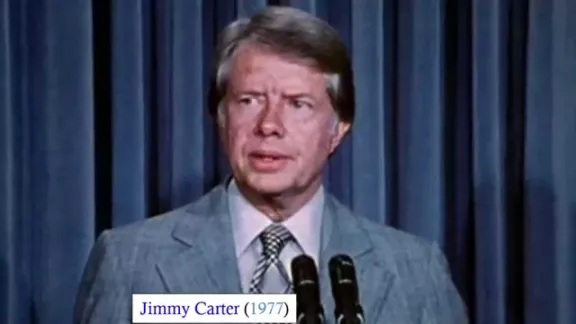
From the Archives: President Struggles To Resolve National Health Care
Despite President Donald Trump’s assertion that “Nobody knew healthcare could be so complicated,” it has, in fact, been a thorn in the side of presidents for decades.
In this look back into Synapse’s archives, we remember May, 1977 when President Jimmy Carter faced his own unsuccessful struggle at resolving the unending problem of national healthcare.
Synapse - The UCSF student newspaper, Volume 21, Number 27, 12 May 1977
National health insurance tied to health cost control
By Jamie Robinson
Jimmy Carter was elected to the Presidency partly on his promise to create a national health insurance program. His first months in office were marked by criticisms of Ford administration delays and with accelerated timetables for the promised Carter plan.
Then the press releases and Presidential addresses began to focus on the inflating prices for health care and on the need for some form of cost control. The plans and timetables for health insurance were quietly shelved.
A major fight began to develop over the new administration’s proposals to limit the rate at which the government would reimburse health care providers.
National health insurance was once seen by the liberal establishment as the cure for all the nation's health woes. It is now increasingly being viewed as the program which would more than any other push the still manageable problems of today into a full blown crisis over the next few years.
Problem of price
The many different problems afflicting the American health care system
have primarily been manifested as problem of pricing. Many of the citizens of the wealthiest and technologically most advanced nation on earth are unable to afford decent health care. Various government programs in the past, most notably Medicare and Medicaid, have been developed to make health care more accessible.
National health insurance would follow the Medicare and Medicaid model but would extend its benefits to all groups within the nation. The idea of national health insurance has gained popularity over the past decade because the inflation in health costs have driven care beyond the means of not only the elderly and poor beneficiaries of Medicare and Medicaid, but of the middle class.
Double Inflation
The rise in health costs has been stupendous.
In 1975 the total healthcare bill for the nation was $118 billion, more than four times the cost for 1960. In 1976 the national health bill rose 19 percent to $140 billion, an average of $638 for every citizen. The increase in hospital costs has been even more staggering. In 1950 it cost an average of $15 to stay in a hospital for one day.
This year the national average is $175 per hospital day.
California's average is $188 per day. According to studies prepared for the national wage and price council, the general level of consumer prices has increased 125 percent since 1950 while the cost of hospital care has risen more than 1000 percent for the same period.
What is particularly distressing to policymakers in Washington, both in the federal administration and in business, is that these escalating health costs are increasingly being shifted away from individual consumers on, to third party insurers. 90 percent of the nation how has some form of health insurance.
Business has become particularly upset by the cost of the premiums paid into their employee insurance benefit programs. When General Motors first began paying for the health insurance of its workers in 1950.
For example the total cost to the nation for Blue Cross and Blue Shield was $450 million per year. Now GM alone pays $1 billion per year, a bill which has been increasing $100 million yearly.
In 1976 GM's aggregate steel bill from US Steel Corporation fell behind Blue Cross. Blue Shield and Metropolitan Life Insurance as its biggest cost items. The cost of Medicare and Medicaid to the state and federal governments is expected to increase this year from $11 billion to $21 billion and from $25 billion to $30 billion, respectively.
New legislation In April President Carter submitted to Congress a bill designed to combat the health care price inflation by placing a nine percent ceiling on annual increases in hospital expenses.
The price controls would apply to private as well as governmental insurance reimbursements for costs incurred by hospitals. An additional ceiling was placed on major construction expenditures by hospitals in order to reduce those outlays by one third to one half. Most significantly, the Carter proposal was based on an explicit recognition of the casual role played by third party insurance in raising health care fees.
Secretary Joseph Califano of the Department of Health. Education and Welfare (HEW), in delivering the Carter proposal, pointed to the large third health insurance policies as allowing hospitals to operate inefficiently and constantly raise prices.
"Hospitals are unlike any other segment of our economy." Califano said. "They're a big business. There is absolutely no competition... Hospitals... many of them have become obese, if you will. They are not trim."
This week Governor Brown introduced legislation in Sacramento that would mandate similar cost controls in California.
Medicare model
The government concern over health care, and especially hospital, cost increases stems from a general recognition of the inflationary impact of Medicare and Medicaid on the health industry. Health care costs have made their biggest surge since the passage of the Medicare and Medicaid legislation in the 19605. National health insurance is thus the expansion of the Medicare and Medicaid programs to the entire population in order to deal with the problem of inflated costs which was in large part created by those very programs.
The inflationary impact of Medicare and Medicaid stem in large part from the formulas by which they reimburse hospitals and physicians for the care administered to patients covered by the programs.
The key terms of “reasonable cost” and “reasonable charge” were designed to prevent any individual physician or hospital unit from billing patients insured by the government at rates far in excess to those charged private patients.
But neither the complicated formulas developed for hospital reimbursement nor the more readily comprehensible formula for physician reimbursement were designed to prevent average cost increases to all patients in response to the new injections of federal money. Yet that is precisely what has happened.
Aided by the constant flow of federal and state money to finance the cost of increasing numbers of patients, hospitals have steadily raised their fees to cover higher administrative salaries, more sophisticated medical technology, and new construction projects.
Opposition to controls the health establishment which has become used to generous fee increases has reacted strongly against the recent proposals for cost control. The American Hospital Association has publicly come out in opposition to the Carter proposal.
The California Hospital Association is still studying the Brown proposal but has already voiced its opposition, claiming that the reimbursement ceiling could force hospitals to cut back on the quality of care received by the patient.
Previous attempts at health cost — control through state and regional planning agencies have yielded meager results, as the record of health care price increases shows. But even those weak attempts are under attack.
The American Medical Association is currently challenging the constitutionality of the Health Systems Agencies, which are in charge of regional planning, in a North Carolina Federal Court.



